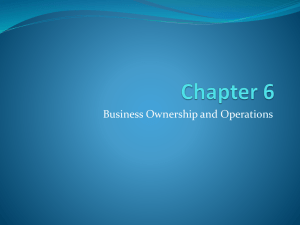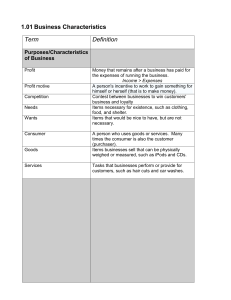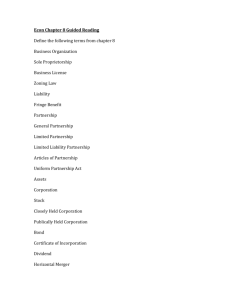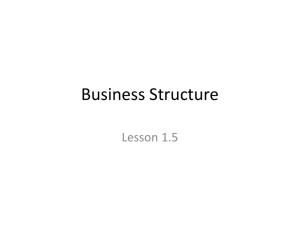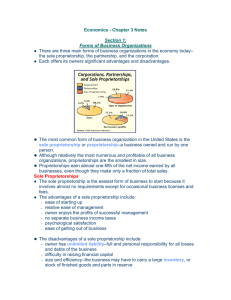BUSINESS STRUCTURES
advertisement
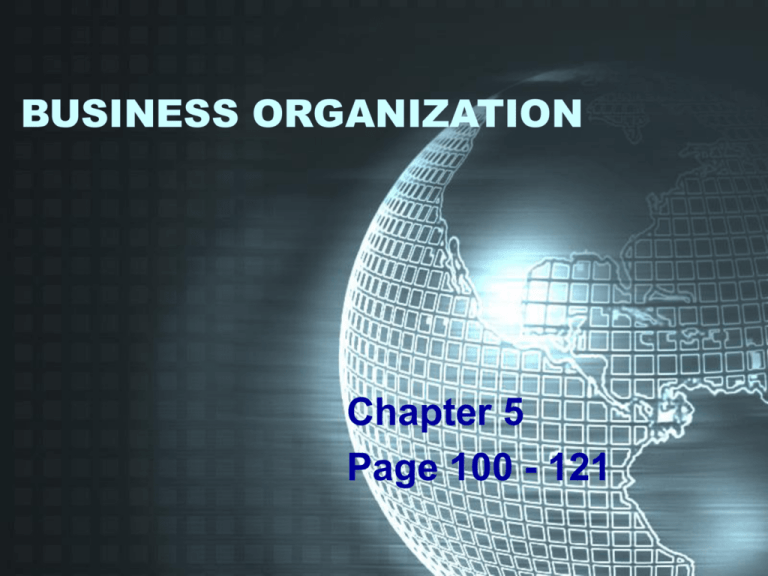
BUSINESS ORGANIZATION Chapter 5 Page 100 - 121 •UNDERSTAND how ownership differs among sole proprietorships, partnerships, and corporations. •GRASP the advantages of the three major types of business ownership. •DESCRIBE the changing status of U.S. employment •DISCUSS the role of business in the U.S. economy. •LEARN the five functions of managers. •RECOGNIZE three specialized forms of business. Types of Business Ownership • Major “types” of business ownership: – Sole proprietorship – Partnership – Corporation SOLE PROPRIETORSHIP A sole proprietorship is a business owned by one person. More than 2/3 of U.S. businesses are operated as sole proprietorships. Nearly 19.5 million businesses have no employees other than the owner. Owner has complete responsibility for all business decisions PARTNERSHIP A partnership is a business owned and managed by a small group, often just two or three people. These partners have a written agreement to share the profits or losses. Partners have unlimited liability for the debts of their business. CORPORATION Operate under written permission. Written permission is called certificate of incorporation. A corporation is a business owned by a number of people (sometimes millions). Owner is known as a shareholder or stockholder. Who’s Running the Show? Managers run the show, that’s who. Dr. Gemma Managers are employees who are responsible for coordinating resources within a business --- human, capital, and natural. Management activities are focused in five key areas: planning, organizing, staffing, leading, and controlling. Who manages the resources here at CDO? Role of Business • Provide employment • Employee wages are used to purchase goods and services • Profits eared by businesses are used to compensate owners and investors. • Most businesses pay taxes to federal, state, and local governments. • Governments spend those taxes to provide services such as streets, parks, libraries, schools, police, etc. Impact on Community • When a new business opens – Pays wages to workers – Buys goods and services from other businesses in the area – This money was not in the community before so businesses and employees use much of the money to purchase things they need. – May result in need for more employees – May result in need to form housing, automobiles, food, and entertainment Business Activities • • • • • • Generating Ideas Raising Capital Employing and Training Personnel Buying Goods and Services Marketing Goods and Services Maintaining Business Records Planning Goals must be set & strategies devised for achieving those goals. Planning involves thinking, gathering and analyzing information, and then making decisions about all phases of the business. Principles of Effective Organization • Responsibility – the obligation to complete specific work. • Authority – the right to make decisions about how responsibilities should e accomplished. • Accountability – taking responsibility for the results achieved. Principles of Effective Organization • Unity of Command – there is a clear reporting relationship for all staff of a business. • Span of Control – the number of employees who are assigned to a particular work task and manager. Business Organization Chart Mrs. Volpe Mr. Enright Mr. Thatcher Mr. Bermudez This function is the process of determining what work has to be done & who is to do each job. Setting Direction • Mission Statement – A mission statement is a short, specific written statement of the reason a business exists and what it wants to achieve. – The mission statement for Starbucks is to “Establish Starbucks as the premier purveyor of the finest coffee in the world while maintaining our uncompromising principles while we grow.” Starbucks uses six guiding principles to measure their progress: their work environment, diversity, high standard, satisfied customers, clean environment, and profits. Setting Direction • Goal – a precise statement of results the business expects to achieve. • Policies – guidelines used in making consistent decisions. • Procedures – descriptions of the way work is to be done. Staffing Mrs. Postil going to work Staffing includes all of the activities involved in finding, selecting, hiring, training, appraising, and rewarding the business’s employees. Leading The work of people must be directed so their tasks will be performed correctly and timely. Effective leaders inspire workers to willingly perform their jobs and accept responsibility for accomplishing the goals of the business. Leading requires good human relations and communications skills. Controlling Controlling means comparing what actually happens with what was planned. Managers must determine to what extent the business is accomplishing the goals it set out to reach in the planning stage. Growing a Business articles of partnership A written agreement that provides the details of the partnership will work. Includes: •Name •Investment •Salaries •Profit and loss share proportions •Responsibilities •Purchase or buy-out rights. Growth Opportunities One way to raise capital and to limit risk is to form a corporation. Soliciting investment from others (going public) has enabled many entrepreneurs to grow into large national or even international businesses. Forming a Corporation Apply for corporation status in the state located Issue and sell shares Receive Articles of Incorporation Call meeting of shareholders to elect board of directors, responsible to guide the operations of the corporation Board of directors elect executive officers, such as President, VPs, CEO, CFO, Treasurer, etc. Earn profits and declare dividends Other Forms of Business Ownership A franchise is a written contract granting permission to sell someone else’s product or service in a prescribed manner, over a certain period of time, and in a specified territory. A franchisee is the person or group of people who received the franchise from a parent company. A franchisor is the parent company granting a franchise. •A franchise is an easy business to start. •The franchisor agrees to help the franchisee get started. •One advantage is national advertising by the parent company. •The franchisor collects a percentage of sales or a flat fee for their services. •Franchises usually require a large investment of capital to start. •Not all franchises succeed. A cooperative is owned by the members it serves and is managed in their interest. A cooperative is much like a regular corporation. Its formation must be approved by the state. It sells shares of stock to its members and has a board of directors. Unlike a corporation, a cooperative is controlled by a vote of members based on service bought from the cooperative and most of the profits are distributed to members at the end of the business year. Non-Profit Corporations Operate to provide a service, but not for profit. Tucson, is a municipal corporation or municipality (a non-profit corporation). Tucson has its own officials, police and fire departments, provides street repairs, street lighting, and other services for its citizens. To do this, Tucson levies taxes and passes rules and regulations to operate effectively. Other groups also organize as non-profit corporations. Among them are private colleges and universities, American Red Cross, Boy Scouts of America, and DECA. Types of Businesses • Producers – Create the products and services used by individuals and businesses. – An extractor is a business that takes resources from nature for direct consumption or for use of development other products • Crops • Lumber • Coal Types of Businesses • Intermediaries – Businesses involved in selling goods and services of producers to consumers and other businesses • Retailers • Wholesalers Types of Businesses • Service Businesses – Carries out activities that are consumed by its customers. It does not offer products for sale. • • • • • • Dentists Physicians Lawyers Pet Sitters Painters Furniture Movers – Fastest growing part of the economy. The Changing U.S. Job Market • Employment data – Number of jobs expected to reach 165 million by 2014 – “Baby boomers” refers to people born between 1946 and 1964 and they have dominated the job market sine the 1960s – The will start retiring in the 2010s – The average age of US workers in 2020 will be over 50 The Changing U.S. Job Market • Employment data – A mini-boom of younger workers will cause the 20- to 30- year-old age group to grow faster for the first time in 25 years – Other groups that will go through higher employment growth rates are Asian, Hispanic, and African-American workers. – Currently white non-Hispanic workers make up 70 percent of the labor force Pressures on Employees • Increased work hours – Downsizing • Streamlined production • Implemented other cost-cutting procedures • Result - employees taking on new tasks and working longer hours. – Recent survey reported that 7 of 10 parents felt they were not able to spend enough time with their children Pressures on Employees • Increased use of contingent workers – One who has no explicit or implicit contract for long-term employment. • About 5% of the US workforce (nearly 6 million people) is made up of contingent workers. • Some estimates project that number will double in 10 years. • Some workers take contingent work because they cannot find permanent jobs, others like the flexibility it offers. Sample Test Questions True or False 1. A sole proprietorship must be chartered by the state in which it is located. 2. A partnership is owned by two or more people who own shares of stock in the company. 3. A corporation is a legal entity and has a life separate from its owners. Sample Test Questions True or False? 1. Managers have to plan, control, lead, staff, and organize. 2. Gathering and analyzing information, and then making decisions about all phases of the business, is called organizing. 3. Determining what work has to be done and who is to do it is called organizing. Sample Test Questions 4. Goals must be set in order to perform the management activity of controlling. 5. Franchises can be operated only as sole proprietorships or partnerships. 6. The person or group who receives a franchise is called the franchisee. 7. A business owned by its members that is managed in the owners’ interests is called a cooperative. Sample Test Questions 1. The form of business that represents two-thirds of U.S. businesses is the a. corporation. b. partnership. c. sole proprietorship. d. cooperative. 2. A form of business that is based on a written agreement about how to manage it and how to share profits is the a. corporation. b. partnership. c. sole proprietorship. d. cooperative. Sample Test Questions 3. The form of business that requires written permission from the state in which it is organized and can have many owners is the a. corporation. b. partnership. c. sole proprietorship. d. cooperative. 4. People who become part owners of a corporation are called a. partners. b. special owners. c. shareholders. d. cooperative owners. Sample Test Questions 5. Which of the following is NOT one of the five activities of business managers? a. planning b. purchasing c. controlling d. staffing 6. Performing the management activities of planning includes a. coming up with strategies to meet goals. b. influencing people. c. staffing the business. d. developing organization charts. Sample Test Questions 7. Assigning jobs to workers and giving authority to certain people is a managing activity called a. planning. b. controlling. c. leading. d. organizing. 8. The part of the profits that are paid to shareholders is called a. excess profit. b. a surplus. c. a dividend. d. none of the above. Sample Test Questions 9. The parent company of a franchise business is known as the a. franchisee. b. franchisor. c. Big Daddy. d. all of the above. 10. Which of the following is NOT true about a non-profit corporation? a. It can be organized to serve citizens. b. It has no shareholders. c. Examples are school clubs, colleges, and service organizations. d. All of the above are true. Sample Test Questions 1. The written permission that allows a corporation to organize is called a _______________________. 2. Directing people so that their work is performed correctly and on time is called ____________________. 3. A ____________________ is a group that is responsible for guiding the operation of a corporation. Sample Test Questions 4. A written contract to sell another’s product or service in a prescribed manner is a ____________________ agreement. 5. Some towns are organized as _____________________ corporations. Assignment Page 120, Review Your Reading Create a Word document, with a header and answer questions 1, 2, and 3. Page 121, Develop Your Business Language #10 through #23 –letter and the term that matches it. For example: 10. i. partnership

